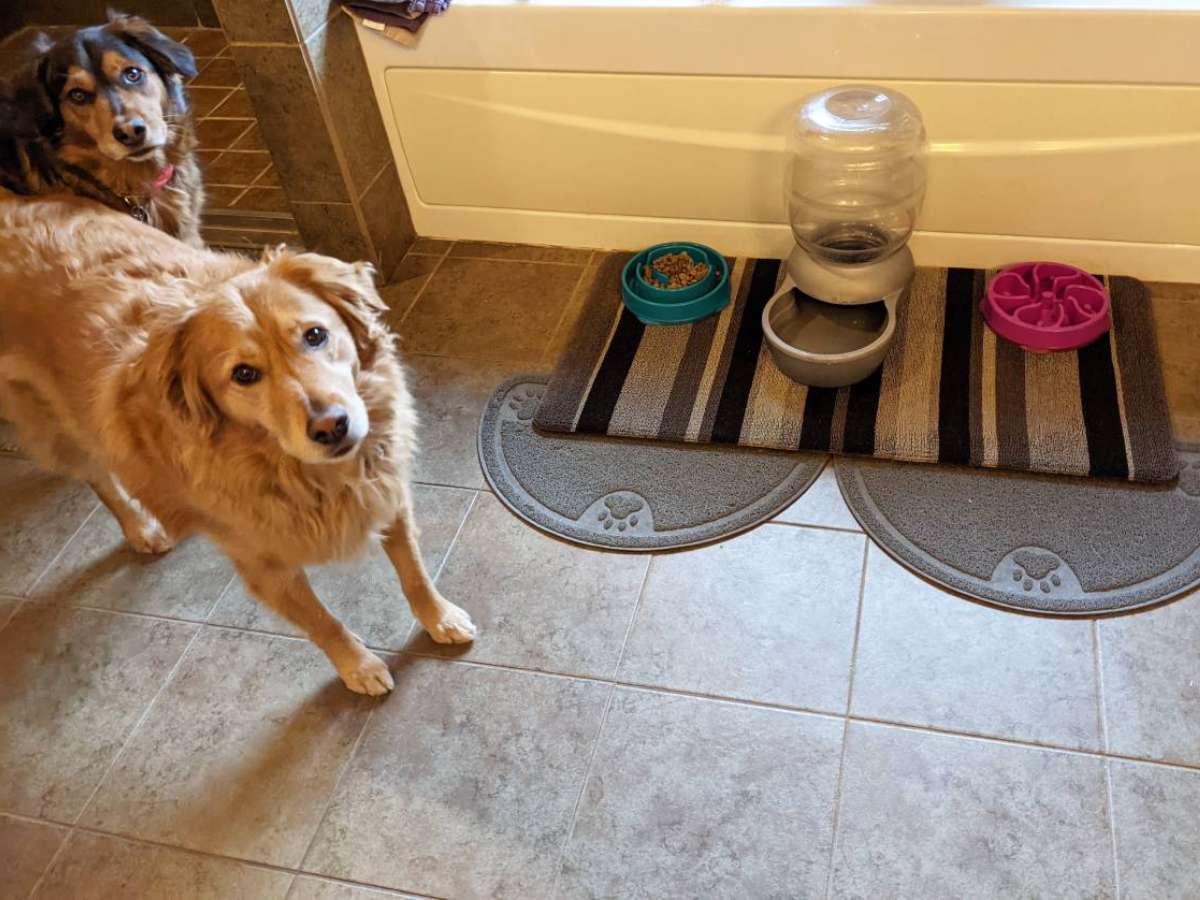 If your dog has seizures, you are not alone.
If your dog has seizures, you are not alone.
Dog seizures can happen in any breed of dog, although there are a few breeds that have a genetic trait that makes them more likely to get seizures.
Idiopathic epilepsy is genetic in many dog breeds and is familial; meaning that it runs in certain families or lines of animals. Breeds most prone to idiopathic epilepsy include the Beagle, Keeshond, Belgian Tervuren, Golden Retriever, Labrador Retriever, Vizsla and Shetland Sheepdog. Multiple genes and recessive modes of inheritance are suggested in the Bernese Mountain Dog and Labrador Retriever, while non-gender hormone recessive traits has been proposed in the Vizsla and Irish Wolfhound. There are also recessive traits in the English Springer Spaniel which can lead to epilepsy, but it does not appear to affect all members of the family. Seizures are mainly focal (involving localized areas of the brain) in the Finnish Spitz. Source
Most dog seizures are associated with a form of dog epilepsy.
Here’s what you need to know (and do!) if you think your dog has had a seizure, plus some videos of dogs having seizures so you can see that dogs typically come out of seizures just fine — even though the dog seizure itself can seem quite violent and scary…
Types Of Dog Seizures
Not all seizures will have your dog on the floor shaking. There are many different types of dog seizures.
Two distinctly different types are quite common:
- In some cases, a seizure may be limited to just your dog’s face or even his legs. This type of seizure is known as partial seizure. You may not even notice that he is having a seizure!
- The moderate or grand mal seizure is the one that most people think of when they hear the word seizure. This is where your dog’s entire body is affected by the seizure. Typically, the dog falls to the floor shaking and he temporarily loses consciousness.
Generalized seizures affect the whole body and can be divided into 2 types, grand mal and petit mal. Grand mal seizures are the most common. A dog experiencing a grand mal seizure usually falls on her side and has uncontrollable muscle activity such as kicking her legs as if swimming or paddling. Salivation is profuse and often the dog involuntarily urinates and defecates. The dog is unaware of you, her surroundings, or her own actions. Petit mal seizures do not result in convulsions, but the animal loses consciousness. It may look like the dog just collapsed. Source
What Dog Seizures Look Like
There are 3 phases to every dog seizure:
- Pre-ictal – Your dog may suddenly become nervous or agitated. While appearing restless, he may start to pace, seek affection, salivate, whine, or hide. These signs occur just minutes before the actual seizure begins. This phase can last anywhere from a few minutes to a few hours.
- Ictal – This is the actual seizure itself. Your dog’s muscles will visibly contract in an uncontrollable spastic motion. Your dog will likely fall over and appear stiff-legged (or paralyzed) while he is convulsing. Your dog may also lose control of his bowels at this time. Dog seizures themselves usually last from a few seconds to a few minutes.
- Post-ictal – Your dog’s seizure is officially over, however he will still be disoriented and confused during this time. He will likely be panting and salivating excessively, and he may even appear to be blind temporarily after the ordeal.
Here are some video examples of dog seizures…
…As you can see, all dogs react differently when they’re having a seizure.
What To Do During A Dog Seizure
Experiencing a dog seizure for the first time can be really scary.
The first thing you need to do is stay calm Believe me, that’s easier said than done!
When my cat had a seizure in the middle of the night, he ended up falling off our bed — which woke me up. I wasn’t calm at all! I was scared. I tried to hold him still. I was yelling at my cat; I was mad at him for peeing on the floor. (I found out later that animals have no control over their bladder during a seizure.)
We got him the medical attention needed, and the vet put him on medication to help control his seizures. He didn’t have another seizure until about 3 years later, and then again 6 months before we lost him.
In addition to remaining calm whenever your dog has a seizure, these tips will also come in handy:
- There’s no need to restrain your dog or try to stop the seizure from happening. Most veterinarians agree that dogs do not feel pain during the seizure itself. Pain may, however, result if your dog falls (off the bed or sofa, for example) or hurts himself during the seizure (by hitting his head on a sharp object, or getting tangled in an electrical cord). Therefore, it’s imp
ortant to move all objects away from your dog while he’s having a seizure, and block off any potentially dangerous areas. For example, if he’s on a bed, at the top of the stairs, on the seat of a vehicle, or somewhere else that’s elevated, try to cushion the area below with lots of blankets & pillows, coats, jackets, stuffed animals, or anything else soft that would make the area immediately around him safer. - Keep your hands and face away from the dog’s mouth at all times. His body is reacting completely beyond his control, therefore while he wouldn’t intend to bite you the dog’s jaws are constantly opening and closing during seizures. Don’t worry… your dog will not swallow his tongue! That’s a myth.
- Stoke your dog’s fur softly throughout the seizure to provide familiarity and comfort to your dog. At the same time, speak to him in a calm, soothing voice simply to reassure that he’s in good hands and everything will be okay. (This actually helps you as much, if not more, than the dog!) Your dog will not be able to hear or respond to you during the seizure itself, but since you won’t know the exact moment that your dog loses consciousness (or regains it), it’s helpful to softly stroke and speak to your dog from start to finish.
- It’s important to determine whether the reason that your dog had a seizure is because he ingested something poisonous, or because he has dog epilepsy or some other health issue. (If your dog swallowed something poisonous, get your dog to the vet or an after-hours clinic immediately.) Each time your dog has a seizure, take notes of what your dog was doing immediately before, how long each seizure lasted, and your dog’s demeanor following the seizure. These things will provide clues that will help your veterinarian properly diagnose and treat your dog’s seizures.
- If your dog’s seizure lasts longer than 5 minutes, or if your dog seems to have trouble breathing, phone your veterinarian or the nearest pet emergency treatment center immediately.
Most dog seizures that only last a couple of minutes are not emergencies. However prolonged fits (status epilepticus) or several fits close together (cluster seizures) can be life-threatening and may require urgent veterinary treatment. Source
Causes Of Dog Seizures
There are many different reasons that your dog may have a seizure.
For one, your dog may have a brain tumor or a head injury. Dog seizures are also frequently caused by distemper or dog epilepsy. However, there are a number of reasons for non-epileptic dog seizures as well.
Other illnesses and ailments can cause seizure-like symptoms in dogs as well, including low blood sugar, disease of the middle ear, cardiac disease, and respiratory disease — to name just a few.
It is important to keep your epileptic dog as free from chemical pollutants as possible. Think about the environment your dog is living in. Do you use chemical sprays on your lawn? Dogs will sometimes seize only when the lawn is sprayed for weeds. How about the cleaner you use for the floor? Some dogs have been known to seize after the floor has been washed with a pine scented cleaner. Flea and tick medications can also cause seizures. It is recommended that epileptic dogs be given Interceptor as a monthly heartworm preventative and Frontline used for fleas. Avoid products with Ivermectin it has been known to cause seizures in some breeds. There are many things that can lower a dog’s seizure threshold. It is also a known phenomenon that some dogs may seizure around the full moon. Source
The characteristics associated with genetic epilepsy usually manifests from 10 months to 3 years of age, but has been reported as early as 6 months and as late as 5 years. Source
Treatments For Dog Seizures
The type of treatment prescribed for your dog’s seizures will depend on what’s causing the seizures in the first place.
Dog epilepsy itself cannot usually be cured, which means that your dog may need to be on anti-seizure medication for the rest of his life. The primary objective of your vet prescribing conventional medicine is not to cure dog epilepsy, but rather to control it. Unfortunately, many of drugs commonly prescribed to treat dog epilepsy (like phenobarbitol) tend to have some fairly serious side effects.
Medical treatment is generally advised for animals who have one or more seizures per month. Animals who have cluster seizures or go into status epilepticus may be treated even though the rate of incidence is greater than once per month. Successful drug therapy depends upon the owner’s dedication to delivering the drug exactly as prescribed, with absolutely NO changes in the dose or type of medication without veterinary consultation. Haphazard drug administration or abrupt changes in medication is worse than no treatment at all, and may cause status epilepticus … The goal of treatment is to decrease the frequency and severity of seizures and avoid unacceptable side effects. It may not be possible to stop the seizures altogether. Source
There are a number of natural remedies for some dog seizures that might be worth considering. For example, skullcap has been shown to help with seizures. It’s an herb that’s safe for dogs. Here are some dog owners’ views regarding various natural remedies for dog epilepsy.
Giving your dog a daily dose of vitamins and supplements may help to control seizures, as well.
Dog acupuncture is not usually a substitute for anti-seizure medicine, but rather it’s used in conjunction with the meds.
Changing your dog’s diet may also help to reduce the number and extent of his seizures. It is believed that adding digestive enzymes to a dog’s diet (which could be in the form of raw food, among other things), will block or eliminate dangerous neurostimulants in the brain.
If the seizure is caused by low blood sugar, give your dog some honey or corn syrup to quickly elevate his blood sugar. (Using a large plastic honey bottle works best, so you can squirt the honey into his mouth without getting your hands too close to his teeth.) Be sure to use a dish or a wooden spoon to administer the sugars to avoid injury to you. [After the seizure], the honey or corn syrup will burn off quickly and needs to be supplemented by his normal food. Source
If a dog’s seizures are bad enough and the result of something like a tumor, the vet may recommend surgery to help control the seizures. This is usually a last resort though. For example, canine brain tumors can be treated with radiation, chemotherapy or removal through surgery, however removing a canine brain tumor is difficult depending on the location and size of the tumor. (Dogs that are exposed to radiation therapy can live at least a year after treatment.)
IMPORTANT: While your dog is receiving treatment for his seizures, he should not be permitted near water (like a swimming pool or a lake), in order to avoid accidentally drowning should a seizure occur.
Does your dog sleepwalk or have very active dreams lately? Some people think their dogs are just dreaming or sleepwalking, when in fact it’s a good possibility that their dogs may be having seizures.



